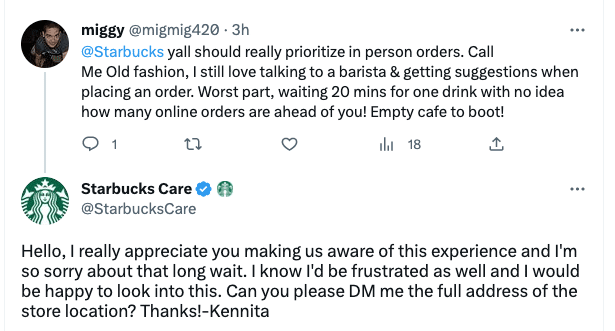Customer happiness is a key ingredient for business growth. A satisfied client simply buys more, engages in repeat purchases, shows greater loyalty, and is willing to pay higher prices. Numerous studies explain how positive customer experience directly impacts sales, revenue, and market share.
On the other hand, unhappiness quickly drives customers away. About half of consumers say they will change brands after one negative service experience. And that number jumps to close to 90% after three negative experiences.
Even worse, dissatisfied customers are vocal. That can lead to negative word-of-mouth, a loss in brand reputation, and a drastic increase in chargebacks. Bad service harms your business.
So how do you solve the problem of a dissatisfied customer? Read on to discover all you need to know about converting unhappy customers into repeat buyers where you'll learn:
- What causes customer dissatisfaction?
- The impact of a negative customer
- How to resolve customer dissatisfaction
- Steps for creating a positive customer experience
Why Do Customers Become Unhappy?
Unhappiness occurs when a customer becomes aware of a business shortcoming. At some level, your product or service has not met expectations. The customer feels you did not satisfy their needs or wants, so dissatisfaction grows.
Usually, there is a snowball effect. Several different factors combine to create a negative experience. Common reasons for customer unhappiness include:
- Issues with quality: A user may feel frustration from a perceived lack of product performance, service features, or longevity.
- Pricing to value gaps: Your business solves a customer pain point that is of value to the user. But if the price to purchase is too high compared to the delivered value, consumers feel discontent.
- Issues with usability: A user may feel irritation if they cannot operate or use the product's features. Disorganized services, impersonal design, and complexity all contribute to low usability.
Lack of service or communication: The sales journey involves several barriers to purchase. Standard friction with shipping, payment, and security can all deter a customer. And customers want support during those moments of stress. If they receive zero help (or worse, rude business staff), unhappiness may arise.
The Impact of an Unhappy Customer
An unhappy customer creates several negative consequences:
- Bad feedback: Just as a happy customer becomes an advocate for business, an unhappy client can spread negative word of mouth. The average client who has a bad experience will tell 16 other people. And with how valuable public online reviews are, your business reputation can crater from just a handful of dissatisfied clients.
- Loss of new leads: Not only will an unhappy customer hurt your reputation, but they can hurt lead generation. 21% of consumers say they will lose trust in a business after negative word of mouth — even if they are not a current customer. Considering that 88% of global consumers state they trust recommendations from friends and family over any other advertising channel, bad word of mouth can be detrimental.
- Employee Churn: Unhappy customers create higher levels of stress for employees. Frontline workers feel the brunt of any consumer dissatisfaction, causing reduced morale.
- Loss of revenue via chargebacks: Unhappy customers are more likely to engage in chargeback fraud. Up to 43% of companies identified customer service delays as a top reason for their increase in chargebacks. Buyer's remorse and using disputes to express discontent are other commonly cited reasons. Chargebacks directly hurt your bottom line.
Unhappiness damages the current and potential Customer Lifetime Value (CLV) of your market base. That includes all future loyalty, advocacy, and possible sales. You also have all the costs related to any chargebacks and employee churn. It is well worth your time to invest in a customer experience strategy that converts dissatisfied customers into repeat buyers.
Steps Customer Support Teams Can Take To Resolve Customer Dissatisfaction
Luckily, there are several action steps you can take to address consumer unhappiness.
1. Resolving Complaints
You have power in an apology. Responding to negative feedback in a positive manner can often retain a client who otherwise would go elsewhere. Your resolution efforts can eliminate many of the negative impacts related to unhappy customers, remember a customer with a resolved complaint is less likely to post negative reviews, feel buyer's remorse, engage in chargebacks, or spread bad word of mouth. Top-notch customer communication management is the perfect tool for converting unhappy customers.
Some common strategies for complaint resolution include:
- Offering full and partial refunds: Refunds address a value gap perceived by your customers. By offering an exchange of funds, you earn back the satisfaction of someone who felt the product did not meet expectations. You might lose the sale, but you retain the customer.
- Escalation: If a customer complaint is complex, escalate the problem to higher levels of management. It shows commitment and priority to the customer (and top authorities can use extra resources to help solve a complaint).
Validation: Recognize the emotions a customer feels with empathy. When you validate a client's requests, you build trust and foster communication toward better outcomes.
| Complaint resolution with Amazon
Amazon has a sterling reputation for consumer satisfaction (the tech company earns top ranks in multiple categories of the American Customer Satisfaction Index). But that rank has slipped a little in recent years. When asked how the company plans to address unhappiness issues, satisfaction reps offered the obvious solution: resolve customer complaints. A given example included answering 80% of all phone support requests within 60 seconds or less and by 30 seconds via chat support. |
2. Building Trust with Transparency
When customers feel misled, distrust grows. And without trust, it is nearly impossible to sustain a long-term customer-to-business relationship. A frustrated client is more likely to feel buyer's remorse and rarely returns as a repeat buyer.
Fortunately, there are several common business areas where you can resolve transparency gaps:
- Crafting fair return policies
- Ensuring clear Terms and Conditions
- Implementing recognizable billing descriptors
- Transparent pricing
- Detailed product information
- Securing data storage and privacy
For example, make all business and product pages easy to read. Post all store policies in accessible areas. Write clear product data and billing items. Such transparency supports customer satisfaction. And that’s l in addition to another primary benefit: the reduction of chargebacks. Clear refund policies and billing descriptors are key methods for eliminating friendly fraud.
| Transparency with Target
Target is known for its transparent practices. The company has won the industry award in the Consumer Discretion category and ranks sixth on the overall index set by the Transparency Awards. It is no surprise then that company manages to earn rising sales revenue with a sticky customer base. And that's all within a difficult demographic and going up against heavy competition (e.g. Costco and Home Depot). |
3. Elevating your post purchase experience
The post-purchase experience is the final step of the customer journey. At this stage, your customers determine whether your business failed or met their expectations. If failed, unhappiness sets in. With such a critical juncture, it pays to improve your post-purchase experience.
Here are some common customer experience improvement strategies:
- Create personal follow-ups: A follow-up expresses concern. And the more points of communication (even with a lost customer), the better-reported happiness levels. Avoid using bots or generic emails — personalize all material to help encourage repeat purchases.
- Pay attention to the last mile: Surveys show that 49% of American consumers will file a chargeback if they don’t receive a delivery within five days — a clear sign of customer dissatisfaction. Invest in last-mile solutions that help streamline fulfillment and reduce the time to value.
- Provide purchase Info: Sending receipts, confirmation of shipment, delivery notifications, and service info after the sale all improve communication and showcase transparency.
- Build easy return methods: We already stated that refunds help solve complaints and buyer's remorse. But refunds also cost less than chargebacks and have a better chance of earning back customer satisfaction. Make it easy for customers to exchange items with customer service.
- Limit chargebacks: Chargebacks and disputes are just as much of a nuisance for an honest consumer as your business. A long, drawn-out dispute process can destroy the post-purchase experience. Invest in solutions such as fraud prevention tools, secure payment processing, dispute teams, service policies, and chargeback insurance.
Offer Rewards: Loyalty programs, rewards for user-generated content, and referral programs can stimulate repeat purchases and build a happy customer relationship.
| How to Implement a Post-Purchase Experience With Justt
Justt is made up of a team of experts at resolving chargebacks. They list several additional strategies you can deploy to improve your pre and post-purchase experience. In addition, the company offers partnered organizations a combination of payments know-how with proprietary chargeback mitigation technology. Together, these create tailor-made solutions that use machine learning to grow smarter over time. And it works — Justt typically sees a 2X improvement in chargeback win rates for clients. |
4. Leveraging Social Media
Social platforms create spaces for a community. It is another connection point you can have with your customer. Ideally, you can use the platforms as a service method — offer an omnichannel customer experience to help build customer engagement and satisfaction.
Possible social media activities:
- Respond to regular mentions
- Share user-generated content
- Offer live support
- Give in-app guidance
- Set up live Q&As
- Provide educational materials
- Implement social listening tools (e.g. surveys, polls)
| Social service with Starbucks
Starbucks runs a robust social media campaign. The coffee chain runs most of its customer communication through its apps. Service teams can offer a seamless service experience through user comments, rewards, and even a dedicated customer service page: |


Takeaway: Invest in the Customer Experience
Customer unhappiness has a direct impact on business profitability. From the cost of lost customers to a high chargeback rate, revenue drops when the customer has a bad service experience. It pays to focus on keeping happy customers.
Luckily, making a hyper-personalized customer experience does not require large upfront investments. Whether it's investing in customer service, clear refund policies, or chargeback mitigation tools, you can give your customers positive interactions that result in repeat buyers.
Before trying to act on transforming opinions, why not try starting with internal teams?
Ensure your payments, service and experience teams are aligned by reading through our article on enabling cross-team collaboration to build better processes.











